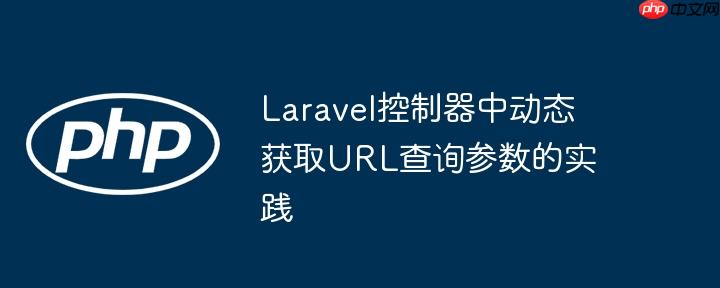
在构建现代Web应用时,我们经常需要根据用户在前端界面的选择或操作,向后端发送带有动态参数的请求。这些动态参数通常通过URL路径段或查询字符串(Query String)的形式传递。本教程将以一个常见的“文章点赞”功能为例,深入探讨如何在Laravel控制器中优雅地获取并处理这些动态传递的查询参数。
假设我们有一个文章详情页,用户可以对文章进行不同类型的点赞,例如“心形点赞”或“手指点赞”。在前端Blade模板中,我们通过不同的链接来触发这些操作:
<a href="/article/{{ $article->id }}/like?type=heart" class="btn btn-primary">Like Heart</a>
<a href="/article/{{ $article->id }}/like?type=finger" class="btn btn-primary">Like Finger</a>这些链接指向同一个路由:
// web.php
Route::get('article/{id}/like', 'App\Http\Controllers\ArticleController@postLike');后端ArticleController中的postLike方法负责处理点赞逻辑,包括检查用户是否已点赞、设置Cookie和更新文章点赞计数。最初的实现尝试通过request('like')来获取点赞类型:
// App\Http\Controllers\ArticleController.php
public function postLike($id) {
$article = Article::find($id);
// 错误尝试:这里无法获取到URL查询参数中的'type'
$like = request('like');
if ($article->hasLikedToday($article->id, $like)) {
return response()
->json(['message' => 'You have already liked the Article #'.$article->id.' with '.$like.'.']);
}
// ... 后续逻辑 ...
$cookie = $article->setLikeCookie($article->id, $like);
$article->increment('like_{$like}');
return response()
->json([
'message' => 'Liked the Article #'.$article->id.' with '.$like.'.',
'cookie_json' => $cookie->getValue(),
])
->withCookie($cookie);
}这里的问题在于,URL中的参数是?type=heart,而request('like')尝试获取名为like的请求参数,这显然是无法成功的。我们需要一种机制来准确地获取URL查询字符串中的type参数。
Laravel提供了一个功能强大的Illuminate\Http\Request对象,它封装了当前HTTP请求的所有信息,包括查询参数、表单数据、文件上传等。通过在控制器方法中进行依赖注入,我们可以轻松访问这个对象。
1. 引入Request类
首先,在控制器文件的顶部引入Illuminate\Http\Request命名空间:
use Illuminate\Http\Request;
2. 在控制器方法中注入Request对象
将Request $request作为参数添加到postLike方法中。Laravel的依赖注入容器会自动为我们解析并提供当前的请求实例:
public function postLike($id, Request $request)
{
// ... 方法体 ...
}3. 获取查询参数
现在,我们可以使用$request对象提供的input()方法来获取URL查询字符串中的参数。input()方法可以获取所有类型的请求参数(包括查询参数、表单数据等),是获取请求数据的通用方法。如果明确知道是查询参数,也可以使用$request-youjiankuohaophpcnquery('parameter_name')。
public function postLike($id, Request $request)
{
$article = Article::find($id);
// 正确获取URL查询参数中的'type'
$type = $request->input('type');
// 或者 $type = $request->query('type');
if ($article->hasLikedToday($article->id, $type)) {
return response()
->json(['message' => 'You have already liked the Article #'.$article->id.' with '.$type.'.']);
}
$cookie = $article->setLikeCookie($article->id, $type);
// 注意:这里的increment方法参数需要动态拼接,例如:
// $article->increment('like_' . $type);
// 如果数据库字段是 like_heart, like_finger
// 确保数据库字段存在或进行相应处理
$article->increment('like_' . $type);
return response()
->json([
'message' => 'Liked the Article #'.$article->id.' with '.$type.'.',
'cookie_json' => $cookie->getValue(),
])
->withCookie($cookie);
}通过上述修改,$type变量将正确地获取到URL中type参数的值(例如heart或finger),从而使点赞逻辑能够根据用户选择的类型进行处理。
为了更好地理解,我们提供一个包含核心逻辑的完整示例。
1. Blade 模板 (resources/views/article.blade.php)
<!DOCTYPE html>
<html lang="en">
<head>
<meta charset="UTF-8">
<meta name="viewport" content="width=device-width, initial-scale=1.0">
<title>Article Detail</title>
<link href="https://cdn.jsdelivr.net/npm/bootstrap@5.3.0/dist/css/bootstrap.min.css" rel="stylesheet">
</head>
<body>
<div class="container mt-5">
<h1>Article Title (ID: {{ $article->id }})</h1>
<p>This is the content of the article.</p>
<div class="mt-4">
<h4>Like this article:</h4>
<a href="/article/{{ $article->id }}/like?type=heart" class="btn btn-primary me-2">❤️ Like Heart</a>
<a href="/article/{{ $article->id }}/like?type=finger" class="btn btn-success">? Like Finger</a>
</div>
<div class="mt-4">
<h5>Current Article Likes Cookie:</h5>
<pre>{{ $articleLikesJson }}</pre>
</div>
</div>
</body>
</html>(注意:为使此示例运行,您需要一个Article模型实例传递给视图,例如在路由中查询一个文章。)
2. 路由定义 (routes/web.php)
<?php
use Illuminate\Support\Facades\Route;
use App\Http\Controllers\ArticleController;
use App\Models\Article; // 假设您有一个Article模型
Route::get('/article/{id}', function ($id) {
$article = Article::find($id); // 示例:查找文章
if (!$article) {
abort(404);
}
$articleLikesJson = \Cookie::get('article_likes', '{}');
return view('article')->with([
'article' => $article,
'articleLikesJson' => $articleLikesJson,
]);
});
Route::get('article/{id}/like', [ArticleController::class, 'postLike']);3. 控制器 (app/Http/Controllers/ArticleController.php)
<?php
namespace App\Http\Controllers;
use Illuminate\Http\Request;
use App\Models\Article; // 假设您有一个Article模型
use Carbon\Carbon; // 用于日期处理
class ArticleController extends Controller
{
public function postLike($id, Request $request)
{
$article = Article::find($id);
if (!$article) {
return response()->json(['message' => 'Article not found.'], 404);
}
// 核心改变:从Request对象中获取'type'参数
$type = $request->input('type');
// 验证$type是否有效,防止恶意输入
$allowedTypes = ['heart', 'finger'];
if (!in_array($type, $allowedTypes)) {
return response()->json(['message' => 'Invalid like type provided.'], 400);
}
if ($article->hasLikedToday($article->id, $type)) {
return response()
->json([
'message' => 'You have already liked the Article #' . $article->id . ' with ' . $type . ' today.',
]);
}
$cookie = $article->setLikeCookie($article->id, $type);
// 动态更新点赞计数,假设数据库字段为 like_heart 和 like_finger
$article->increment('like_' . $type); // 确保数据库中存在 'like_heart' 或 'like_finger' 字段
return response()
->json([
'message' => 'Liked the Article #' . $article->id . ' with ' . $type . '.',
'cookie_json' => $cookie->getValue(),
])
->withCookie($cookie);
}
}4. Article 模型中的辅助方法 (app/Models/Article.php)
<?php
namespace App\Models;
use Illuminate\Database\Eloquent\Factories\HasFactory;
use Illuminate\Database\Eloquent\Model;
use Illuminate\Support\Facades\Cookie;
use Carbon\Carbon;
class Article extends Model
{
use HasFactory;
// 假设您的文章表有 id, title, content, like_heart, like_finger 等字段
protected $fillable = ['title', 'content', 'like_heart', 'like_finger'];
public static function hasLikedToday($articleId, string $type)
{
$articleLikesJson = Cookie::get('article_likes', '{}');
$articleLikes = json_decode($articleLikesJson, true);
if (! array_key_exists($articleId, $articleLikes) || ! array_key_exists($type, $articleLikes[$articleId])) {
return false;
}
$likeDatetime = Carbon::createFromFormat('Y-m-d H:i:s', $articleLikes[$articleId][$type]);
// 检查点赞时间是否在今天之内
return ! $likeDatetime->addDay()->lt(now());
}
public static function setLikeCookie($articleId, string $type)
{
$articleLikesJson = Cookie::get('article_likes', '{}'); // 默认值应为 {} 而非 []
$articleLikes = json_decode($articleLikesJson, true);
$articleLikes[$articleId][$type] = now()->format('Y-m-d H:i:s'); // 使用 now() 获取当前时间
$articleLikesJson = json_encode($articleLikes);
return cookie()->forever('article_likes', $articleLikesJson);
}
}(注意:请确保您的articles表中有like_heart和like_finger等字段,并且它们是可更新的。)
// web.php
Route::get('article/{article}/like', [ArticleController::class, 'postLike']);
// ArticleController.php
public function postLike(Article $article, Request $request) { /* ... */ }这样,Laravel会自动根据{article}参数的值从数据库中查找对应的文章实例。
通过在Laravel控制器方法中注入Illuminate\Http\Request对象,我们可以轻松、安全地访问和处理来自URL查询字符串的动态参数。这不仅解决了本教程中点赞类型传递的问题,更是构建灵活、交互式Web应用程序的基础。掌握Request对象的使用,是每个Laravel开发者必备的技能,它能帮助我们更高效地处理用户请求并实现复杂的业务逻辑。
以上就是Laravel控制器中动态获取URL查询参数的实践的详细内容,更多请关注php中文网其它相关文章!

每个人都需要一台速度更快、更稳定的 PC。随着时间的推移,垃圾文件、旧注册表数据和不必要的后台进程会占用资源并降低性能。幸运的是,许多工具可以让 Windows 保持平稳运行。

Copyright 2014-2025 https://www.php.cn/ All Rights Reserved | php.cn | 湘ICP备2023035733号